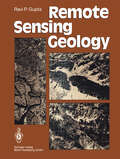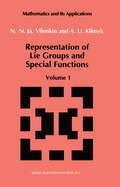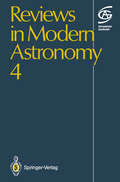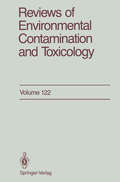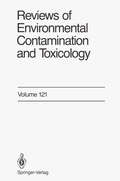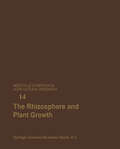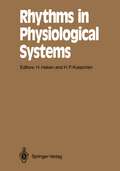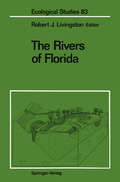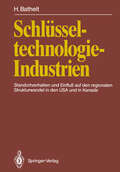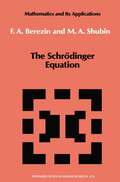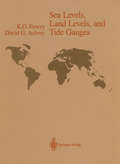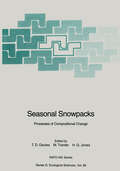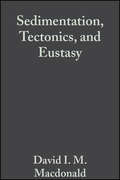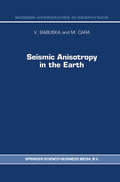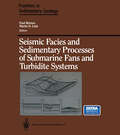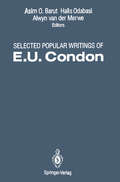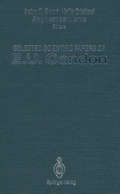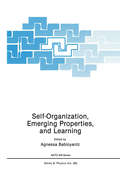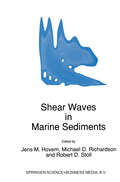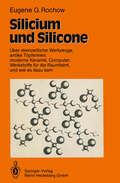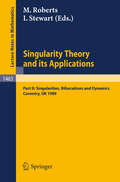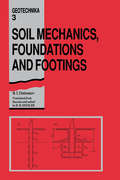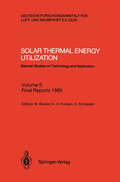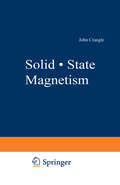- Table View
- List View
Remote Sensing Geology
by Ravi P. GuptaThere has been phenomenal growth in the field of remote sensing over the last two to three decades. It has been applied in the fields of geology, mineral exploration, forestry, agriculture, hydrology, soils, land use etc. - that is, in all pursuits of sciences dealing with the features, processes, and phenomena operating at the earth's surface. The status of geological remote sensing has rapidly advanced and the scientific literature is scattered. The aim of the present book is to systematically discuss the specific requirements of geological remote sensing, to summarize the techniques of remote sensing data collection and interpretation, and to integrate the technique into geoexploration. The main conceptual features of the book are: - To combine various aspects of geological remote sensing, ranging from the laboratory spectra of minerals and rocks to aerial and space-borne remote sensmg. - To integrate photogeology into remote sensing. - To promote remote sensing as a tool in integrated geoexploration. - To elucidate the wide-spectrum geoscientific applications of remote sensing, ranging from meso- to global scale. The book has been written to satisfy the needs of mainly graduate students and active research workers interested in applied earth sciences. It is primarily concept -oriented rather than system- or module-oriented.
Representation of Lie Groups and Special Functions: Volume 1: Simplest Lie Groups, Special Functions and Integral Transforms (Mathematics and its Applications #72)
by N.Ja. Vilenkin A.U. KlimykReviews in Modern Astronomy (Reviews in Modern Astronomy #4)
by Gerhard KlareThe yearbook series Reviews in Modern Astronomy of the Astronomische Gesell three years ago in order to bring the scientific events schaft (AG) was established of the meetings of the society to the attention of the worldwide astronomical community. Reviews in Modern Astronomy is devoted exclusively to the invited reviews, the Karl Schwarzschild lectures, and the highlight contributions from leading scientists reporting on recent progress and scientific achievements at their research institutes. Volume 4 comprises all, eighteen contributions which were presented during the fall meeting of the AG at Preiburg/Breisgau in September 1990. They cover problems in solar research and the solar system as well as the first results of the ROSAT and Hipparcos space missions, stellar and extragalactic studies, and Supernova 1987A in the Large Magellanic Cloud. The Karl Schwarzschild Medal was awarded to Professor Eugene Parker1. His lecture entitled "Convection, Spontaneous Discontinuities, and Stellar Winds and X-Ray Emis·sion" begins this volume.
Reviews of Environmental Contamination and Toxicology: Continuation of Residue Reviews (Reviews of Environmental Contamination and Toxicology #122)
by George W. WareReviews of Environmental Contamination and Toxicology publishes authoritative reviews on the occurrence, effects, and fate of pesticide residues and other environmental contaminants. It will keep you informed of the latest significant issues by providing in-depth information in the areas of analytical chemistry, agricultural microbiology, biochemistry, human and veterinary medicine, toxicology, and food technology.
Reviews of Environmental Contamination and Toxicology: Continuation of Residue Reviews (Reviews of Environmental Contamination and Toxicology #121)
by George W. WareReviews of Environmental Contamination and Toxicology publishes authoritative reviews on the occurrence, effects, and fate of pesticide residues and other environmental contaminants. It will keep you informed of the latest significant issues by providing in-depth information in the areas of analytical chemistry, agricultural microbiology, biochemistry, human and veterinary medicine, toxicology, and food technology.
The Rhizosphere and Plant Growth: Papers presented at a Symposium held May 8–11, 1989, at the Beltsville Agricultural Research Center (BARC), Beltsville, Maryland (Beltsville Symposia in Agricultural Research #14)
by Donald L. Keister Perry B. CreganPapers Presented at a Symposium held May 8--11, 1989, at the Beltsville Agricultural Research Center (BARC), Beltsville, Maryland, U.S.A.
Rhythms in Physiological Systems: Proceedings of the International Symposium at Schloß Elmau, Bavaria, October 22–25, 1990 (Springer Series in Synergetics #55)
by Hermann Haken Hans P. KoepchenRhythms are a basic phenomenon in all physiological systems. They cover an enormous range of frequencies with periods from the order of milliseconds up to some years. They are described by many disciplines and are investigated usually in the context of the physiology of the respective function or organ. The importance given to the research on rhythmicity is quite different in different systems. In some cases where the functional significance is obvious rhythms are at the center of interest, as in the case of respiration or locomotion. In other fields they are considered more or less as interesting epiphenomena or at best as indicators without essential functional significance, as in the case of cardiovascular or EEG rhythms. Recently the study of physiological rhythms has attracted growing interest in several fields, especially with respect to rhythm research in humans and its rapidly spreading applications in basic behavioral research, and as a diagnostic tool in clinical medicine. This development was favored by two methodological and conceptual ad vances: on the one hand, the availability of non-invasive methods of continu ous recording of physiological parameters and their computer-assisted evaluation, and on the other, the rapid development of theoretical analyses, for example, the understanding of dynamic systems, the generation of coordinated macroscopic pro cesses in systems comprising many single elements, and the mathematical tools for treating nonlinear oscillators and their mutual coupling.
The Rivers of Florida (Ecological Studies #83)
by L. Ager D.G., Jr. Bass A. F. Clewell C. L. DeMort L. K. Dixon J. H. Epler E. D. Estevez E. A. Fernald M. S. Flannery T. H. Fraser K. M. Hammett F. Jr. Jordan W. R. Karsteter C. C Koenig J. A Kushlan S. F. Leitman B. F. McPherson C. Mesing A.K.S.K. Prasad G. L. RayThis book addresses basic questions concerning the ecological relationships and current conditions of the major river systems in Florida . . There have been relatively few comprehensive studies made of the rivers of Florida. There is, to be sure, voluminous information that addresses various aspects of riverine ecology. However, little such information has been collected in a way that allows even a preliminary understanding of the driving forces that determine how the diverse freshwater and associated brackish systems function. This lack of useful data is the product of a fundamental ignorance concerning the scale of endeavor, both spatially and temporally, that is needed if we are to understand and, parenthetically, manage the major drainage systems of this area of the country (Livingston, 1987). Research used to address management problems should entail a continuous series of interrelated studies, descriptive and experimental, that answer the immediate (and often less important) questions that are asked on a day-to-day basis. The research should also be designed to answer questions that have not yet been asked. In other words, ecosystem research should be organized on an appropriate scale so that system-wide processes are understood and pr
Schlüsseltechnologie-Industrien: Standortverhalten und Einfluß auf den regionalen Strukturwandel in den USA und in Kanada
by Harald BatheltSea Levels, Land Levels, and Tide Gauges
by K.O. Emery David G. AubreyChanges in sea level caused by global warming can be disastrous to modern civilization. Therefore, it is important to use accurate and reliable methods to monitor any change. During this century, and, in particular, the last three decades, tide-gauge records have been used to show these changes related to the world's oceans. Aubrey and Emery suggest, however, that tidal gauges should not be used unquestioningly as a benchmark for measuring eustatic sea-level changes. Tectonism, subsidence, ocean current variability, and human activity can, and do, affect the accuracy of these records. Understanding the reasons for changes in land and sea levels is essential for the proper development of coastal regions. The results of this study provide guiding data for scientific, engineering, and policy solutions to coastal flooding. Determining the true causes of relative subsidence, and how to use geological and oceanological controls, will allow us to exist within our natural environment, rather than force nature to conform to our legal and temporary 'remedies.'
Seasonal Snowpacks: Processes of Compositional Change (Nato ASI Subseries G: #28)
by Trevor D. Davies Martyn Tranter H. Gerald JonesSeasonal Snowpacks examines the processes which control the chemistry of seasonal snowcover and provides detailed information on the biogeographical distribution of snow (e.g. urban, alpine snowpacks), snow composition (e.g. micropollutants, stable isotopes) or the physical and biological processes which influence the chemical changes in snow (e.g. wind, microbiological activity). The fluxes of chemicals at the snow-atmosphere and snow-soil interfaces are examined, as are processes which modify composition within the snowcover. It is the first book in which the reader will find a comprehensive overview of the theoretical concepts, latest measurement techniques, process-oriented research methods, and models of studies in snow chemistry. The linkages between snow chemistry, atmospheric chemistry and hydrology will make this book of use to both research workers and students in the physical and biological sciences and to natural resource management personnel.
Sedimentation, Tectonics and Eustasy: Sea-Level Changes at Active Margins (International Association Of Sedimentologists Series)
by David I. M. MacdonaldOver the last ten years, seismic and sequence stratigraphic studies have emphasized the role of worldwide fluctuations in sea level in controlling patterns of sedimentation. Widely recognized cycles of coastal onlap are thought to have been caused by such global changes. This postgraduate and reference text contains contributions from an international team of specialists. The book is based upon an IAS meeting which focused attention on the situation at active plate margins, covering three major themes: the underlying mechanics and rates of relative sea-level change at active plate margins; the interaction of eustatic and tectonic processes at modern margins; recognition of the products in the sedimentary record and possible criteria for distinguishing global eustatic from local tectonic effects. This book is intended for those studying and working in sedimentology, basin analysis, exploration geophysics and petroleum geology.
Seismic Facies and Sedimentary Processes of Submarine Fans and Turbidite Systems (Frontiers in Sedimentary Geology)
by Paul Weimer Martin H. LinkThe Frontiers in Sedimentary Geology series was established for the student, the researcher, and the applied scientist to enhance their potential to stay abreast of the most recent ideas and developments and to become familiar with certain topics in the field of sedimentary geology. This series deals with subjects that are in the forefront of both scientific and economic interests. The treatment of a subject in an individual volume, therefore, should be a combina tion of topical, regional, and interdisciplinary approaches. The interdisciplinary aspects are becoming more and more important because most studies dealing with the natural sciences cannot effectively stand alone. Although this thrust may sound simple, in reality it is not, basi cally because each discipline has developed its own jargon and definitions ofterms. Communi cation among disciplines is a major issue and can be accomplished more constructively when people with different backgrounds join together at the same symposium and can read from the same volume rather than confining themselves within the world of their own specialty meetings and journals. Books in this series provide this connective link between disciplines. Each book in this series provides a continuous and connected flow of concepts throughout the volume by the use of introductory chapters that outline a topic to help the reader grasp its problems and to understand the contributions that follow.
Selected Popular Writings of E.U. Condon
by E.U. Condon0 e The selected popular writings contain articles he wrote on technical topics for such journals as The American Journal of Physics, Science, and Nature, as well as reflections on education, UFO's, and other topics.
Selected Scientific Papers of E.U. Condon
by E.U. CondonE.U. Condon's major contributions were in atomic and molecular physics and spectroscopy; his book with G.H. Shortley on The Theory of Atomic Spectra dominated the field of spectroscopy for half a century and remains an invaluable reference. He also played an important role in the institutions of American science. He served for many years as the editor of Reviews of Modern Physics, and with Hugh Odishaw he edited the still widely used Handbook of Physics. After World War II, Condon became director of the National Bureau of Standards (now NIST), and helped to make it one of the premier research laboratories in the physical sciences in the world. The Selected Scientific Papers reprint many of the most important contributions Condon made to atomic physics, quantum theory, nuclear physics, condensed-matter physics and other fields. The Selected Popular Writings contain articles he wrote on technical topics for such journals as The American Journal of Physics, Science, and Nature, as well as reflections on education, UFO's, and other topics.
Self-Organization, Emerging Properties, and Learning (Nato Science Series B: #260)
by Agnessa BabloyantzThis volume contains the proceedings of the workshop held in March 1990 at Austin, Texas on Self-Organization, Emerging Properties and Learning. The workshop was co-sponsored by NATO Scientific Affairs Division, Solvay Institutes of Physics and Chemistry, the University of Texas at Austin and IC2 Institute at Austin. It gathered representatives from a large spectrum of scientific endeavour. The subject matter of self-organization extends over several fields such as hydrodynamics, chemistry, biology, neural networks and social sciences. Several key concepts are common to all these different disciplines. In general the self-organization processes in these fields are described in the framework of the nonlinear dynamics, which also governs the mechanisms underlying the learning processes. Because of this common language, it is expected that any progress in one area could benefit other fields, thus a beneficial cross fertilization may result. In last two decades many workshops and conferences had been organized in various specific fields dealing with self-organization and emerging properties of systems. The aim of the workshop in Austin was to bring together researchers from seemingly unrelated areas and interested in self-organization, emerg{ng properties and learning capabilities of interconnected multi-unit systems. The hope was to initiate interesting exchange and lively discussions. The expectations of the organiziers are materialized in this unusual collection of papers, which brings together in a single volume representative research from many related fields. Thus this volume gives to the reader a wider perspective over the generality and ramifications of the key concepts of self organization.
Shear Waves in Marine Sediments
by J. M Hovem Michael D. Richardson Robert D. StollShear waves and closely related interface waves (Rayleigh, Stoneley and Scholte) play an important role in many areas of engineering, geophysics and underwater acoustics. In some cases interest is focused on large-amplitude waves of low frequency such as those associ ated with earthquakes and nuclear explosions; in other cases low amplitude waves, which have often travelled great distances through the sediment, are of interest. Both low and high frequency shear and interface waves are often used for seafloor probing and sediment characterization. As a result of the wide spectrum of different interests, different disciplines have developed lines of research and a literature particularly suited to their own problems. For example water-column acousticians view the seafloor sediment as the lower boundary of their domain and are interested in shear and interface waves in the near bottom sediments mainly from the standpoint of how they influence absorption and reflection at this boundary. On the other hand, geophysicists seeking deep oil deposits are interested in the maximum penetration into the sediments and the tell-tale characteristics of the seismic waves that have encountered potential oil or gas bearing strata. In another area, geotechnical engineers use shear and interface waves to study soil properties necessary for the design and the siting of seafloor structures.
Silicium und Silicone: Über steinzeitliche Werkzeuge, antike Töpfereien, moderne Keramik, Computer, Werkstoffe für die Raumfahrt, und wie es dazu kam
by Eugene G. RochowEugene G. Rochow, Prof. emerit. der Harvard Universität, führte am 10. Mai 1940 ein Laborexperiment durch, das für die industrielle Produktion von Siliconen von grundlegender Bedeutung war: die Rochow-Synthese. Durch diese Synthese wurden die "Wundermaterialien" zugänglich für viele Anwendungen zur Verbesserung von Gebrauchsgegenständen, zur Miniaturisierung von elektronischen Bauelementen und zur Herstellung von Raumanzügen für Astronauten, die die extreme Hitze und Kälte auf dem Mond aushielten.
Singularity Theory and its Applications: Warwick 1989, Part II: Singularities, Bifurcations and Dynamics (Lecture Notes in Mathematics #1463)
by Mark Roberts Ian StewartA workshop on Singularities, Bifuraction and Dynamics was held at Warwick in July 1989, as part of a year-long symposium on Singularity Theory and its applications. The proceedings fall into two halves: Volume I mainly on connections with algebraic geometry and volume II on connections with dynamical systems theory, bifurcation theory and applications in the sciences. The papers are original research, stimulated by the symposium and workshop: All have been refereed and none will appear elsewhere. The main topic of volume II is new methods for the study of bifurcations in nonlinear dynamical systems, and applications of these.
Soil Mechanics, Footings and Foundations: Geotechnika - Selected Translations of Russian Geotechnical Literature 3
by B.I. DalmatovTranslated from the second Russian edition of 1988. Parts 2, "Soil mechanics" and 3, "Foundations and footings" are revised and updated versions of the first Russian edition of 1981. Part 1, "Special course in engineering geology," contains a discussion of physicomechanical properties of soil, geody
Soil Mechanics, Footings and Foundations: Geotechnika - Selected Translations of Russian Geotechnical Literature 3
by B.I. DalmatovTranslated from the second Russian edition of 1988. Parts 2, "Soil mechanics" and 3, "Foundations and footings" are revised and updated versions of the first Russian edition of 1981. Part 1, "Special course in engineering geology," contains a discussion of physicomechanical properties of soil, geody
Solar Thermal Energy Utilization: German Studies on Technology and Application
by Manfred Becker Karl-Heinz Funken Gernot SchneiderSolid · State Magnetism
by John CrangleSolid state magnetism is important and attempts to understand magnetic properties have led to an increasingly deep insight into the fundamental make up of solids. Both experimental and theoretical research into magnetism continue to be very active, yet there is still much ground to cover before there can be a full understanding. There is a strong interplay between the developments of materials science and of magnetism. Hundreds of new materials have been dis covered, often with previously unobserved and puzzling magnetic prop erties. A large and growing technology exists that is based on the magnetic properties of materials. Very many devices used in everyday life involve magnetism and new applications are being invented all the time. Under standing the fundamental background to the applications is vital to using and developing them. The aim of this book is to provide a simple, up-to-date introduction to the study of solid state magnetism, both intrinsic and technical. It is designed to meet the needs and interests of advanced undergraduate students reading physics; of postgraduates in physical and materials sciences and in engineering; and also those of the practising scientist specializing in another area who requires an introduction to magnetism.
